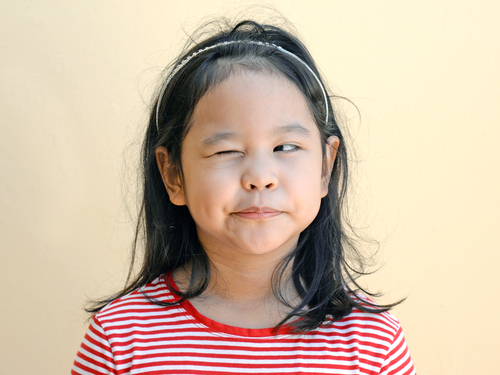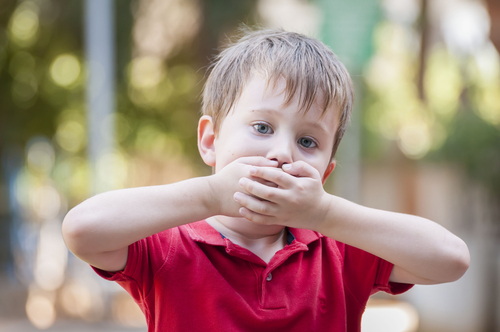Tics are short-lasting movements or sounds that interrupt normal behavior in children and adults. They are usually repetitive and can worse when a child is stressed or sleep deprived. Tics in children occur more often in boys than girls and while not involuntary, they aren’t easy for a child to control.
Examples of tics in children include squinting, hand flapping, contracting shoulder muscles, repetitive frowning, licking lips, or rapid blinking. For a parent, tics in children can be disconcerting. They can be annoying. But it’s important to note that as unexpectedly as they appear, they usually resolve themselves with time and don’t require intervention.
Also, keep in mind that tics, while disturbing at times, do not mean your child is developing Tourette’s Syndrome. A genetically neurological disorder, Tourette’s Syndrome is “characterized by repetitive, stereotyped, involuntary movements and vocalizations called tics.”

About Tics
Generally, there are two types of tics: motor and vocal. Motor tics are short sudden movements; vocal tics or sounds made that occur suddenly and repetitively. An example of a motor tic might be a child who twitches her nose, grimaces, or squints or crosses his eyes multiple times. A vocal tic might be repetitive sniffling, a clearing of the throat or coughing, clicking of the tongue, or humming.
Motor tics are further classified as either simple or complex. A simple motor tic is a single isolated movement. A complex motor tic consists of a series of tics performed in the same order. For example, a child might twist his head sideways and contract his shoulder blades or squint eyes and furrow the brow. Every tic is unique and the sequence is individual.

Tics are not involuntary but are sometimes termed “unvoluntary” movements. This means that kids can learn how to suppress the tic for a short period of time. But suppression of any tic can be uncomfortable and may not be relieved until the child can do it.
According to the American Academy of Pediatrics, tics can occur in up to 20 percent of school age children. In most cases, tics are transient, or passing. It’s unclear why tics start but stress and sleep deprivation can make them more severe.
Causes
Tics in children generally occur when another comorbid condition exists or triggers the tics. For example, children with ADHD can develop tics. Also tics can occur with anxiety conditions, autism spectrum disorder, obsessive-compulsive disorder, and many others. Tics can also occur occasionally in untreated strep infections. Known as P.A.N.D.A. or pediatric autoimmune neuropsychiatric disorders associates with streptococcal infections, these tics seem to worse overnight in children with obsessive-compulsive disorder (OCD) or Tourette’s c0an develop strep infections.
Other comorbid conditions that can trigger tics include allergies. A child with dry itchy eyes or nose is at risk for developing a tic of clearing the throat, blinking or squinting the eyes, or sniffling until the irritant is eliminated or reduced.
Treatments
Doctors generally tell parents that tics in children should be ignored, especially if they’re mild and newly occurring. Because most tics are transient, doctors don’t necessarily become concerned unless the tic becomes chronic, severe and debilitating, and lasts longer than a year.
Treatments tend to be individually specific and target comorbid conditions that could be triggering the tics. For example, if the tics are allergy induced, a pediatrician might treat allergy symptoms or take blood work to assess what allergens are problematic for the child. Other treatments might include the following:
Habit Reverse Conditioning: Habit Reversal Conditioning (HRC) or Habit Reversal Therapy (HRT) is a behavioral therapy. It helps a child with tics slowly reverse them by becoming more aware of conditions that contribute to them. It teaches the child alternative behaviors to replace the tic, relaxation techniques to reduce anxiety that can worse tics, and can eradicate them altogether. The therapy can take as long as two to three months to induce notable change in the tics but a child mild begin having some relief in just a few sessions.
Lifestyle changes: Many anxiety-producing situations can worse tics for children. School, movies, or social settings are some environments where the child might feel more self conscious and therefore more anxious. The goal of making lifestyle changes is to incorporate change that reduces the anxiety. After school activities that induce relaxation, exercise, sleep, and mindful meditation exercises are just some activities that help a child with tics. It’s also helpful to meet with teachers if tics are bothersome or disruptive and should work with a therapist to help a child cope.
Guided Meditation: Since stress exacerbates tics, helping children to relax and meditate has health and emotional benefits. Guided meditation is useful for children with ADHD and meditation in general has been shown to improve cognition function, attention, focus, and anxiety levels.
Medication: Medications for treating tics in children can be worse than the tics themselves. Doctors generally choose the least invasive methods to treat tics in children and reserve stronger antipsychotic drugs for chronic, severe tic disorders. The first line of defense in medication includes antihypertensive drugs known as Clonidine and Guanfacine. Both are used as blood pressure medications but have shown to be effective at reducing tics in children. Side effects are less than others medications and may include drowsiness and dizziness, which tend to dissipate with time.
If the tics are associated with ADHD, a doctor may also prescribe a stimulant along with the antihypertensive.
For more tics that don’t respond to hypertensive drugs, doctors may prescribe neuroleptics, a class of antipsychotics used to treat psychosis and schizophrenia where tremors are common. Drugs such as Haloperidol act by reducing the dopamine levels in the brain. Side effects tend to be more severe with neuroleptics and doctors have to children prescribed these drugs.
